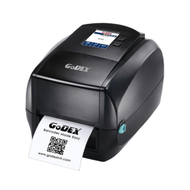Types of Barcodes: Find the Right One for Your Business
11th Aug 2025
TL;DRBarcodes are essential for product labeling, inventory tracking, and point-of-sale systems. 1D Barcodes like UPC-A, EAN-13, and ITF-14 are ideal for retail, packaging, and logistics. 2D Barcodes such as QR Codes, Data Matrix, and GS1 DataMatrix store more data in less space—perfect for healthcare, marketing, and traceability. Choosing the right barcode depends on product size, industry standards, scanning environment, and required data capacity. Use software like BarTender, NiceLabel, Loftware, and TEKLYNX for easy barcode generation. Pair with reliable printers like Godex RT863i, Brother Titan TJ-4010TN, and Seiko SLP720RT to ensure accuracy and durability. For mobile-friendly or marketing use, QR codes are a smart, flexible choice. OmegaBrand offers barcode solutions, printers, software, and supplies to streamline your operations. |
|---|
When it comes to inventory management, product labeling, and point-of-sale systems, selecting the correct barcode can significantly impact operational efficiency. However, with numerous types of barcodes available, from traditional 1D formats like UPC to modern 2D codes like QR, how do you determine which one best suits your business needs?
In this guide, we break down the most common types of barcodes, explaining how each works, its best uses, and the industries that typically rely on them.
What Are Barcodes and How Do They Work?
Barcodes are machine-readable visual representations of data used to identify products, track inventory, and streamline operations across various industries. At their core, barcodes encode information, such as a product number or batch ID, into patterns of lines (1D barcodes) or shapes (2D barcodes) that can be scanned using optical readers or camera-based systems.
When scanned, a barcode reader interprets the pattern and instantly retrieves the encoded data, connecting it to a backend system, such as a point-of-sale terminal or inventory database. Different types of barcodes are used depending on the use case. For example, UPCs are widely used in retail, while QR codes are commonly employed in marketing and mobile applications.
How Has Barcode Technology Evolved Over Time?
Barcode technology has undergone significant evolution since its invention in the 1950s. The first commercial application of a barcode was in 1974, when a pack of chewing gum was scanned using a UPC code. From that moment, barcodes revolutionized how businesses handle data.
Over time, new types of barcodes have been developed to meet the growing demands for increased data density and versatility. 1D barcodes like Code 39 and EAN-13 offered simple encoding, ideal for basic tracking. But as industries required more complex data, 2D barcodes like Data Matrix and QR codes emerged, capable of storing thousands of characters and readable even if partially damaged.
Today, barcode systems are integrated with cloud platforms, mobile devices, and AI-powered scanners, making them faster, smarter, and more resilient than ever.
What Are the Key Components of a Barcode?
Every barcode, regardless of type, relies on a few core components to function correctly:
-
Symbology: This refers to the specific encoding standard or pattern used, such as Code 128 or QR Code. Each symbology has its own set of rules for how data is structured.
-
Quiet Zone: A blank space around the barcode that ensures the scanner can properly distinguish where the barcode begins and ends.
-
Start and Stop Characters: These markers signal to the scanner where the barcode data starts and ends, crucial for accurate reads.
-
Check Digit (optional): A built-in mathematical safeguard that verifies the barcode’s integrity and minimizes read errors.
Understanding these components helps businesses choose the right types of barcodes for their labeling needs, ensuring optimal performance across scanning environments.
What Are the Different 1D Barcode Types and How Are They Used?
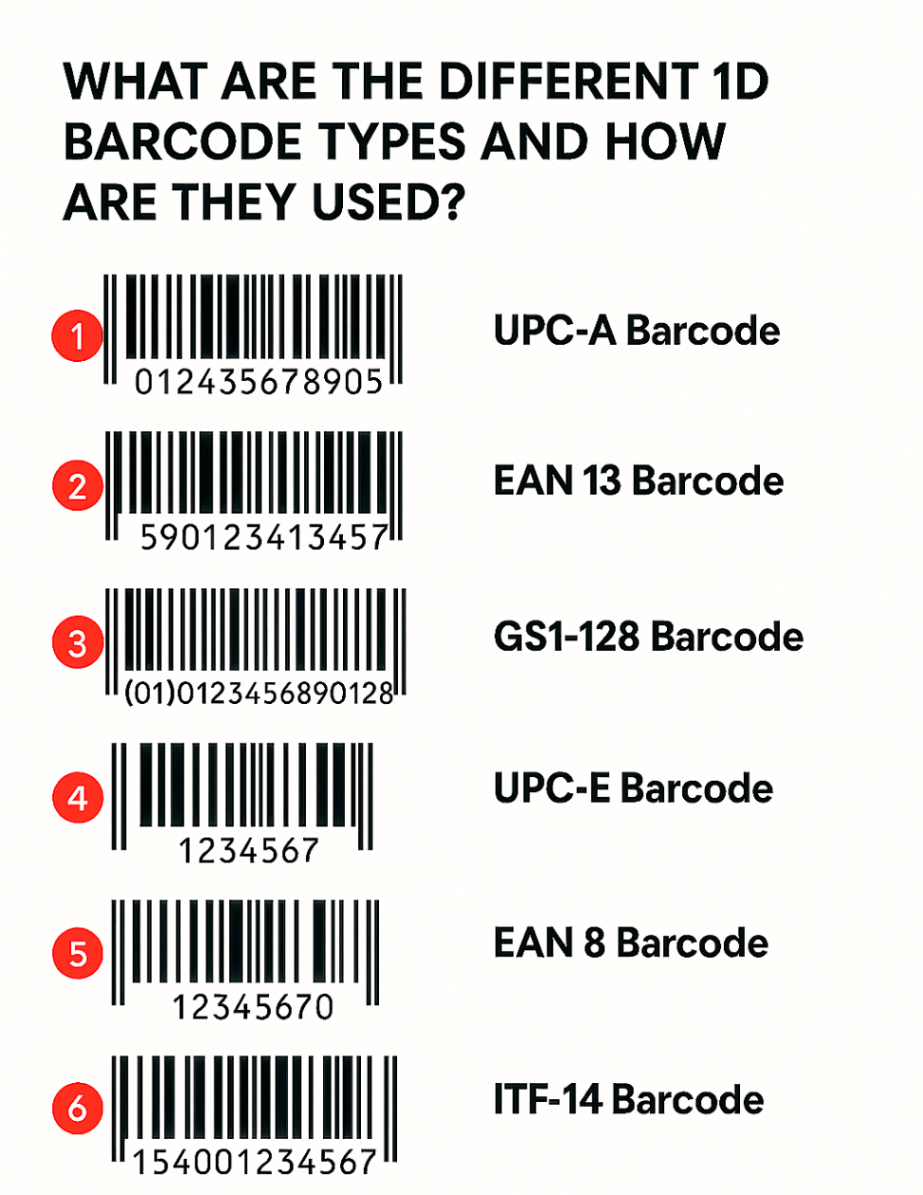
1D barcodes, also known as linear barcodes, are the traditional types of barcodes made up of vertical lines and spaces that represent numeric or alphanumeric data. They’re widely used across industries, from retail to logistics, due to their simplicity and scanning speed. Let’s explore the most common 1D types of barcodes and their applications.
1. UPC-A Barcode
The UPC-A (Universal Product Code-A) is one of the most recognized 1D barcodes, especially in the U.S. retail industry. It contains 12 numeric digits and is used primarily for labeling consumer products in stores. Each digit represents specific product information, including the manufacturer and item number, making it ideal for point-of-sale scanning.
2. EAN 13 Barcode
EAN-13 (European Article Number) is the international counterpart of UPC-A and encodes 13 digits. It’s widely used across Europe and other global markets for retail products. Like the UPC-A, it includes a country code, manufacturer code, and product identifier, making it one of the most widely adopted types of barcodes in global commerce.
3. GS1-128 Barcode
GS1-128 (formerly known as UCC/EAN-128) is a high-density linear barcode that can encode more complex data, such as batch numbers, expiration dates, and serial numbers. It’s commonly used in supply chain management and logistics for tracking pallets, cartons, or items in transit. Unlike other 1D codes, it uses Application Identifiers (AIs) to organize the data format for scanning systems.
4. UPC-E Barcode
UPC-E is a compressed version of the UPC-A barcode. It encodes only 8 digits and is ideal for labeling small products where space is limited, like cosmetics, gum packets, or small electronics. It provides the same basic data as a UPC-A but in a more compact format.
5. EAN 8 Barcode
EAN-8 is another short-format barcode similar to UPC-E. Still, it encodes 8 digits and is typically used for small retail products in markets outside the U.S. It’s popular among manufacturers looking to conserve label space without sacrificing scannability. It’s one of the more niche types of barcodes, perfect for packaging constraints.
6. ITF-14 Barcode
ITF-14 (Interleaved 2 of 5) is designed for packaging and bulk shipping. It encodes 14 numeric digits and is printed directly onto corrugated cardboard or cartons. Because it’s durable and scannable even under rough conditions, it’s a favorite for labeling in warehouses and distribution centers. It ensures that outer packaging is tracked accurately throughout the supply chain.
What Are the Different 2D Barcode Types and How Are They Used?
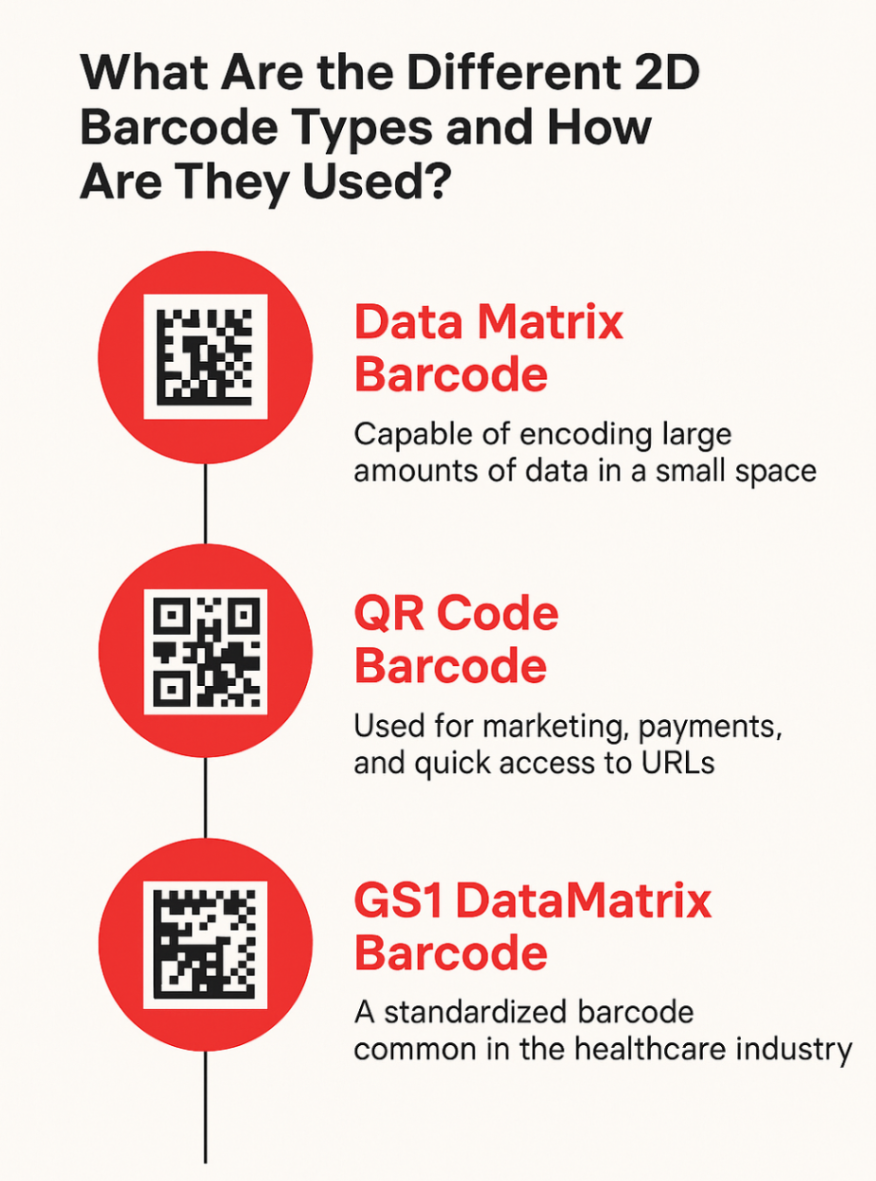
2D barcodes are far more compact and data-rich than traditional linear codes. Unlike 1D barcodes that store data in horizontal lines, 2D barcodes store information both horizontally and vertically, allowing them to hold thousands of characters in a small space.
Let’s break down three widely used 2D barcode types and their applications.
1. Data Matrix Barcode
The Data Matrix barcode is a square-shaped 2D code that can encode large amounts of alphanumeric data in a tiny area. It’s widely used in industries where space is limited, such as electronics, aerospace, and medical devices.
Thanks to its high fault tolerance and readability even on curved or damaged surfaces, the Data Matrix is ideal for asset tracking, micro-labeling, and tagging surgical equipment. It’s also ISO/IEC-compliant and frequently used in UDI (Unique Device Identification) for medical products.
2. QR Code Barcode
QR Codes (Quick Response Codes) are arguably the most familiar 2D barcodes for consumers. They can encode URLs, text, Wi-Fi credentials, contact info, and more. Designed for fast scanning with smartphones, QR codes have become a staple in marketing campaigns, digital menus, event check-ins, and e-commerce packaging.
What makes QR codes unique among other types of barcodes is their ease of adoption. Consumers don’t need specialized scanners, just a smartphone. This has made them a go-to tool for bridging the gap between offline and online customer experiences.
3. GS1 DataMatrix Barcode
The GS1 DataMatrix is a standardized version of the Data Matrix barcode that incorporates GS1 Application Identifiers, ensuring it adheres to global data formatting rules. This barcode is essential in regulated industries like pharmaceuticals, healthcare, and food manufacturing.
It’s used for traceability, compliance, and serialization, allowing companies to encode batch numbers, expiration dates, and Global Trade Item Numbers (GTINs) all within a compact code. When regulatory compliance and supply chain transparency are non-negotiable, GS1 DataMatrix is one of the most trusted types of barcodes available.
How Do You Select the Right Barcode for Your Business?
Whether you’re managing warehouse inventory, printing product labels, or running retail operations, the right barcode type and the right software can improve accuracy, traceability, and speed.
Let’s break down what really matters when deciding which barcode format and generation tool is best for your use case.
What Factors Should You Consider: Volume, Environment, or Use Case?
The first step in selecting a barcode type is to assess how and where the barcode will be used:
-
High-volume retail or logistics? Go with UPC, Code 128, or ITF-14 for fast scanning and reliable supply chain integration.
-
Tiny or curved surfaces? Opt for Data Matrix or EAN-8 barcodes for better print efficiency and readability.
-
Outdoor or harsh environments? Select durable label materials and barcodes, such as GS1-128, designed for rugged scanning conditions.
-
Customer-facing campaigns? Use QR codes, they’re mobile-friendly and bridge the gap between offline interactions and digital platforms.
Each barcode type has its ideal use case. Matching it with your application environment ensures both readability and performance.
What Software and Hardware Is Compatible With Your Business Setup?
Barcode generation and printing require software that’s not only powerful but also compatible with your hardware, printers, and label templates. At OmegaBrand’s Barcode Software Collection, you’ll find professional tools tailored for businesses of all sizes:
-
BarTender Starter – Workstation + Unlimited Printers: Perfect for beginners or small businesses, this plan costs just $199/year and includes unlimited printer support. It lets you create the most popular types of barcodes, from UPCs to QR codes, with easy drag-and-drop label design.
-
BarTender Professional – Workstation + Unlimited Printers: At $299/year, this is your all-in-one barcode labeling powerhouse. It supports advanced label logic, database integrations, and the broadest range of barcode formats, making it ideal for high-speed operations and industries with stringent regulations.
-
NiceLabel, Loftware, and Teklynx solutions are also available via OmegaBrand, offering scalable options for enterprise-level barcode printing, compliance labeling, and RFID integration.
Want to try BarTender before committing? Download the free 30-day trial here and explore its label design tools, barcode templates, and automation features with no upfront cost.
How Can You Future-Proof Your Barcode System for Scalability and Security?
Think beyond your current needs. Can your barcode system keep pace with your expanding product line? Will it support inventory automation, serialization, or global supply chain integration? Choosing flexible barcode software, such as BarTender Professional, ensures you're prepared for regulatory changes, expanded operations, or new packaging formats.
Security is also key. Some barcode formats, such as GS1-128 and DataMatrix, can include encrypted or serialized data for anti-counterfeiting measures. Ensure your software supports advanced encoding and secure printing options to protect your products and brand.
Which Barcode Printers Are Recommended by OmegaBrand?
Choosing the right barcode printer is just as important as selecting the right barcode type or software. Your printer directly affects label durability, print clarity, and compliance with industry standards, particularly in sectors such as manufacturing, logistics, and nutraceutical packaging.
At OmegaBrand, we offer a wide range of reliable and performance-tested barcode printers for both industrial and desktop environments. Below are four highly recommended models, each suited for different needs and label volumes.
Godex RT863i 4-Inch 600 dpi - 3 ips Desktop Thermal Transfer Barcode Label Printer
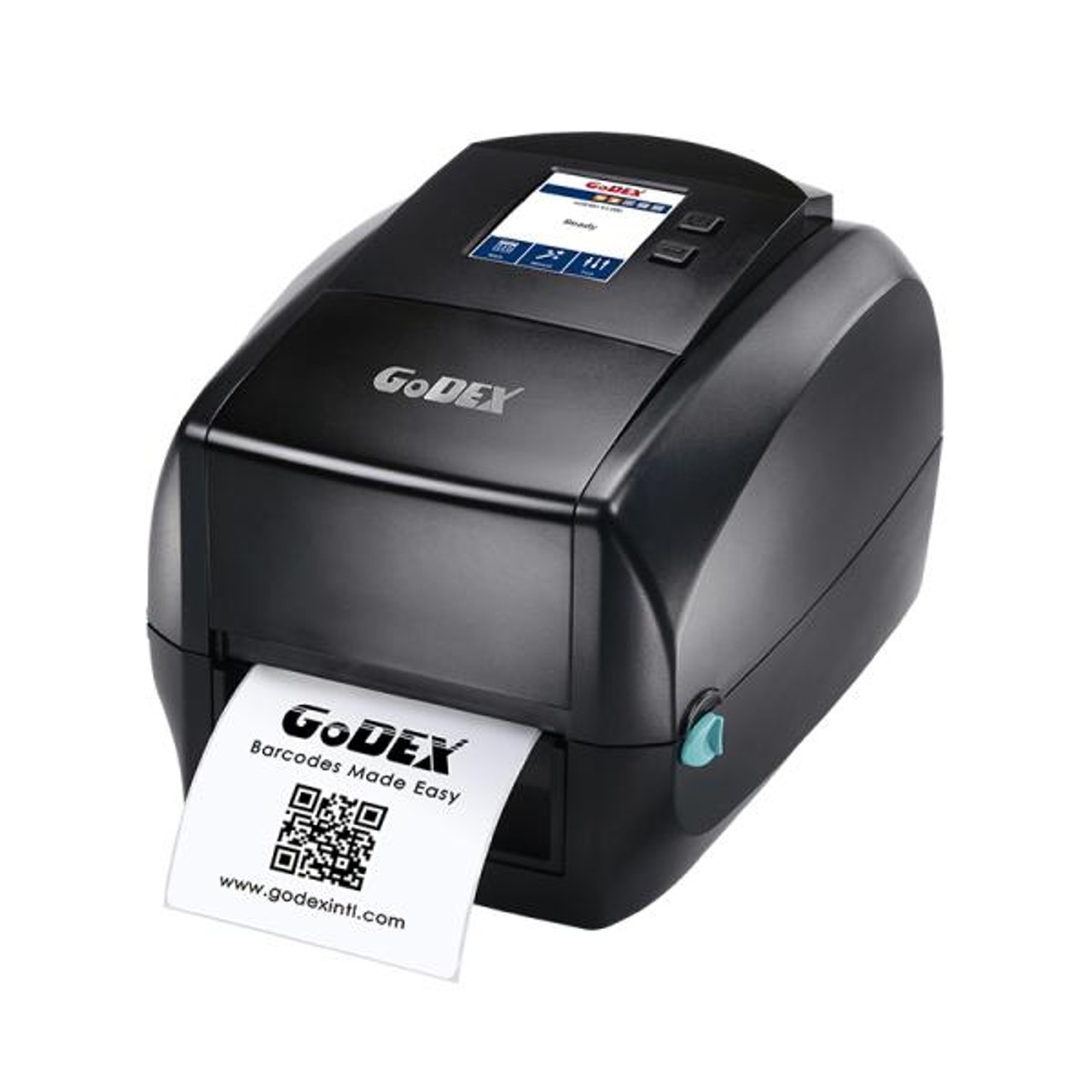
Price: $1,425 USD
Type: Thermal Transfer
Resolution: 600 dpi
Print Width: 4.16"
Best For: Garment care labels, wash care tags, and high-resolution label applications
The Godex RT863i is engineered for businesses that require ultra-high-resolution printing on small or detailed labels. With 600 dpi resolution, it delivers razor-sharp text and barcodes, making it ideal for textile and apparel industries that print care instructions, size tags, or fabric compositions.
This model includes:
-
Guillotine cutter for precision trimming
-
External label unwinder with 3" core support
-
Thermal transfer printing for long-lasting, smudge-free labels
-
Media widths ranging from 0.79" to 4.64"
If you need to print fine text or small-format barcodes with accuracy, the RT863i is an industry-grade performer built for the task.
Brother Titan TJ-4010TN 4.7" | 203 dpi | 6 ips Thermal Transfer Industrial Label Printer with USB/LAN
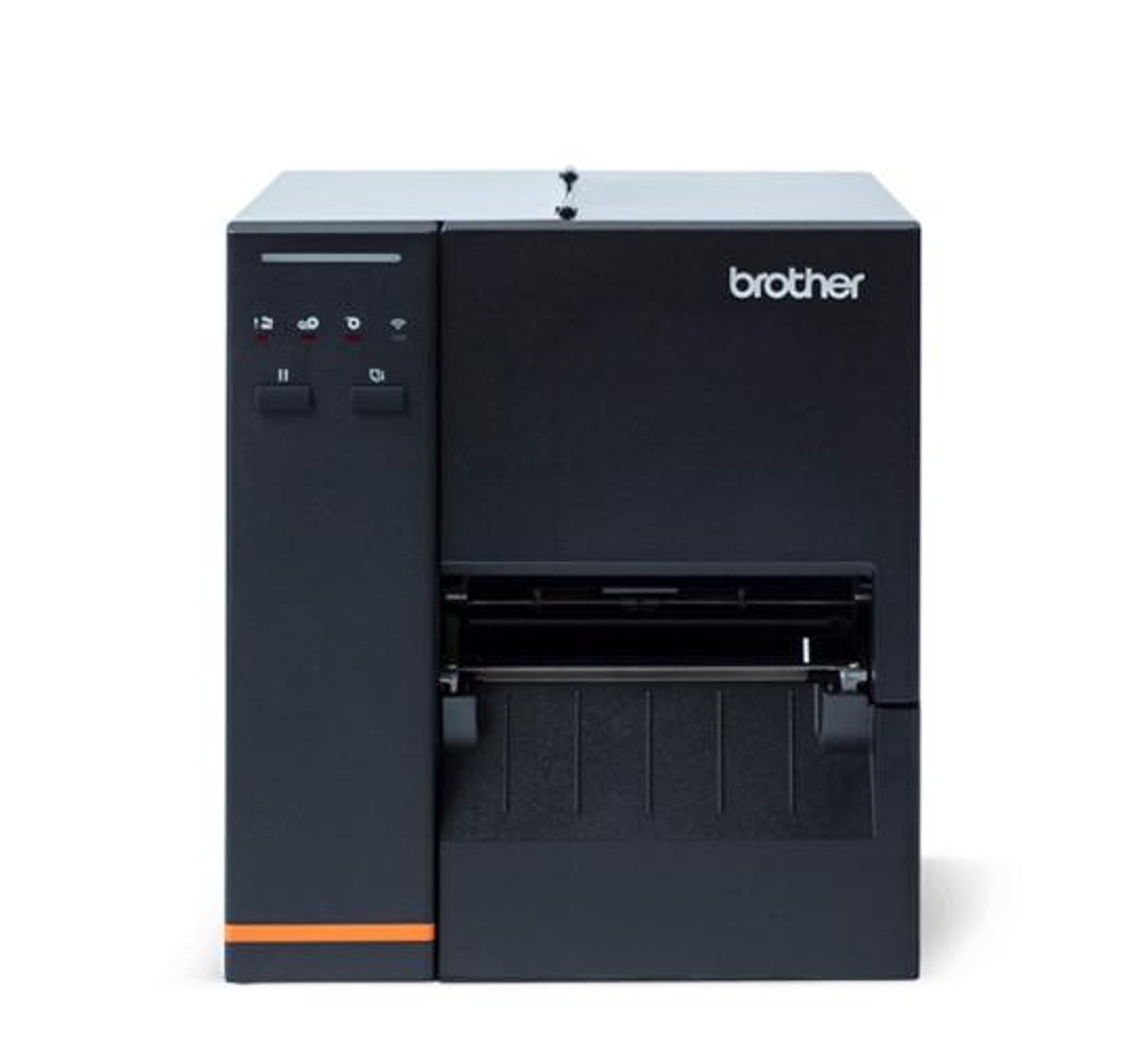
Price: $980 USD
Type: Thermal Transfer
Resolution: 203 dpi
Print Width: 4.7"
Best For: High-volume manufacturing, warehouse logistics, shipping
Designed for rugged environments, the Brother Titan TJ-4010TN is built to deliver fast, consistent printing at 6 inches per second, making it ideal for high-volume label production. With a durable metal frame and support for large label rolls, this printer fits seamlessly into warehouse or industrial production lines.
Key features:
-
Multiple I/O ports: USB, LAN, Serial, Host-USB
-
Compatibility with DT/TT media up to 4.7” wide
-
2-year Premier Warranty
-
Plug-and-play for enterprise-level integration
Whether you're labeling pallets or shipping hundreds of boxes daily, this printer won't miss a beat.
Seiko Instrument SLP720RT 2" Linerless Label Printer w/ WiFi | SLP720RT-W2FU1-03
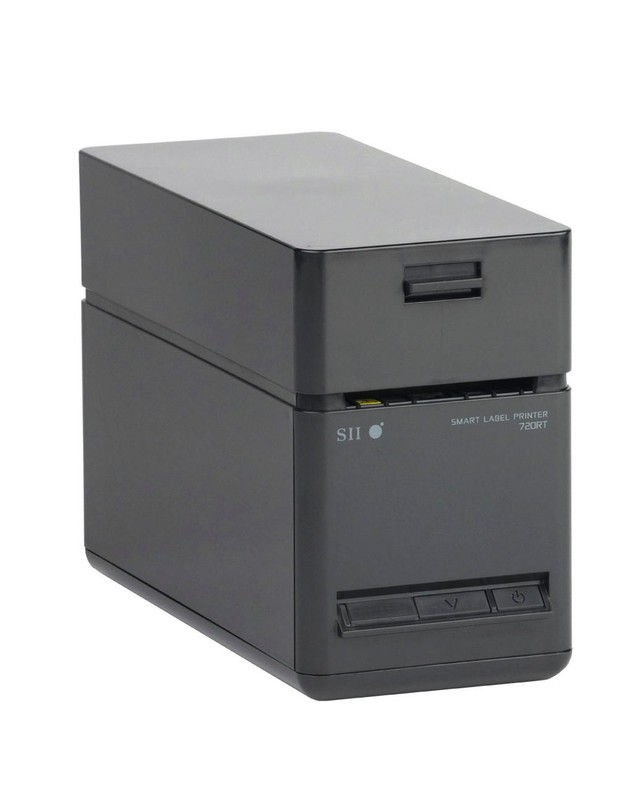
Price: $377.99 USD
Type: Direct Thermal
Resolution: 203 dpi
Print Width: 2"
Best For: Mobile POS, shipping labels, linerless media
The Seiko SLP720RT is a game-changer for businesses seeking to reduce label waste. Designed to work with linerless media, this compact 2" label printer supports WiFi connectivity for wireless label printing from tablets, PCs, and cloud systems.
Why it stands out:
-
Speeds up to 7.87 ips for fast throughput
-
Space-saving design is ideal for retail counters or mobile stations
-
Great for dynamic label lengths without peel waste
-
Reliable wireless operation without cables
If you’re going green and need flexibility in label lengths, this is a powerful yet affordable choice.
Godex GE300 4”-wide 203 dpi desktop Thermal Transfer Barcode Label PrinterCitizen CL-E300XUBNNA 4x6 Shipping Label / Barcode Direct Thermal Printer | USB/LAN
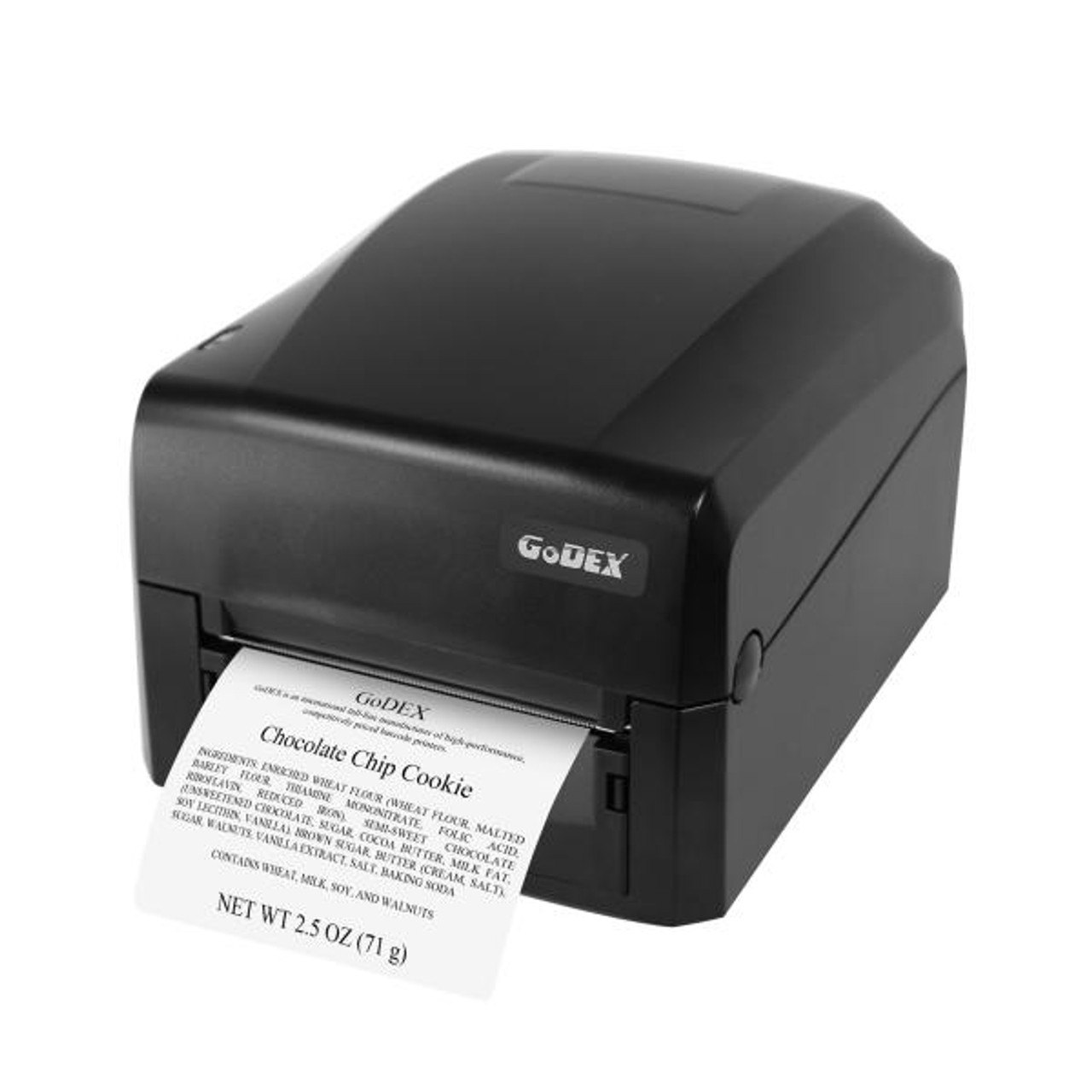
Price: $449 USD
Type: Thermal Transfer
Resolution: 203 dpi
Print Width: 4"
Best For: Product labeling, inventory, and small business operations
The Godex GE300 strikes a perfect balance between performance, footprint, and affordability. With native USB and Ethernet connectivity, it integrates easily into your existing workflow. Plus, you can enhance its functionality with wireless upgrades:
It supports a variety of ribbon types (wax, resin, wax/resin) and works with direct thermal or thermal transfer labels, making it a robust solution for multi-use labeling across departments.
Ready to Print Smarter? OmegaBrand Has You Covered.
From managing retail shelves to tracking pharmaceuticals or powering warehouse logistics, choosing the right type of barcode, and the tools to generate and print it, can transform your business operations. Whether you're using UPC barcodes for fresh produce, Data Matrix codes for small components, or QR codes for smart packaging, success starts with precision, compliance, and clarity.
That’s where OmegaBrand comes in.
We’re your trusted partner for all things barcode, from premium barcode printers and barcode generation software to expert-recommended label materials.
Don’t guess your way through labeling; optimize it.
Explore our full selection of barcode software, barcode printers, and label supplies today.
Conclusion
Barcodes may seem simple, but behind every scan lies a strategic decision: the type of barcode, the material, the printer, and the software that brings it to life. Whether you need fast scans in a retail setting, long-lasting labels for industrial logistics, or compact codes for medical devices, aligning the right barcode technology with your business goals is key.
From UPC barcodes at grocery checkouts to Data Matrix codes on healthcare products, every label tells a story, and with the right setup, it tells it clearly, accurately, and efficiently.
As industries demand more speed, accuracy, and traceability, investing in the right barcode solution isn’t optional; it’s a competitive edge.
Frequently Asked Questions:
What is the main difference between 1D and 2D barcodes?
The main difference lies in data structure. 1D barcodes use the spacings of parallel lines to store numeric characters or consecutive numbers, while 2D barcodes (like matrix codes) use a grid pattern to encode large amounts of data, including alphanumeric characters, images, and even special characters.
Which barcode type is best for retail products?
UPC barcodes are the most widely used type of barcode for retail products, particularly in North America. They are commonly used in grocery stores, retail environments, and point-of-sale systems, storing 12-digit identification numbers that make them ideal for product packaging and retail applications.
Can I use QR codes for inventory management?
Yes, QR codes are ideal for inventory systems that need to encode types of information, such as serial numbers, product specifications, or ASCII character sets. Their error correction and ability to handle vast amounts of data make them ideal for managing healthcare products, tools, or transportation industries.
What DPI resolution is best for my Barcode labels?
For most types of barcode symbology, 200 dpi is sufficient. However, for tiny labels, such as those on small electronic components or photo labs, a 300–600 dpi printer offers the best way to ensure that barcode scanners accurately read dense character sets in a small unit area.

